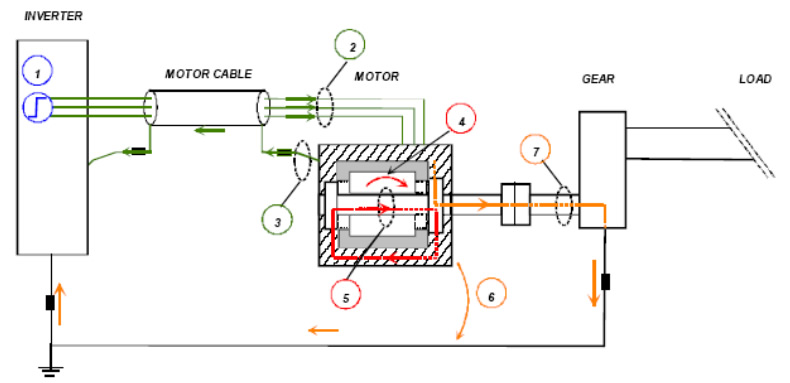23. Electrical currents destroying the bearings
When doing welding operation on existing fan, it is essential to place a grounding clip the nearest possible to the welding zone. Indeed, without this precaution, the welding current tries to use to lowest resistance way between the electrode and the grounding clip. If this way goes through the house bearings, then the bearings may be definitively damaged. For example, while balancing on site, the usual mistake is to weld a “small balancing weight” on the impeller disc while placing the grounding clip on the stator of the fan. Therefore the resulting electrical circuit crosses also the bearing with the consequences explained before.
Another example: the repair of a cracked motor-frame, with the grounding clip and the applied welding point at each side of the motor may create an electrical circuit with lower resistance crossing through the house bearing.
Hence the need to practice such interventions with knowledgeable staff. This subject (the damage due to induced current to the bearings) is as old as the electrical motor itself. Due to the sinusoidal power supply, this induced current take birth from small asymmetries in the magnetic circuit or in the wiring. Nowadays, this kind of current is no longer a problem because well known. The ongoing manufacturing of the motors take it into account.
However, when the variable speed drive use went very popular, a large amount of bearings damages were
observed, without being able to link their origin to the induced current. After some researches in collaboration with universities, the motor manufacturers discovered that it was due to the crossing high frequency currents.
The frequency inverter supplies the motor with high frequency voltage pulses. These create variable regime currents, which are passing through the phase wires and thanks to the parasitic capacitance of the bearings, through the motor stator. The largest part of the current goes back to the inverter via the earth cable. But a part of it is still circulating in several circuits, depending on the installation site and the type of motor manufacturing, creating damages to the bearings according two ways:
1. This current whose distribution is not uniform in the windings can produce a high induced voltage between the ends of the motor shaft. This creates therefore a high frequency current circulating in the two bearing and in the motor frame. The probability of this current birth is directly depending on the size and power motor, the voltage supplied and the switching frequency of inverter. This current is dangerous for the bearings motor of high size and it cross it with same amplitude in both bearings.

2. The impedance of the return circuit currents with a variable regime has for effect to modify the voltage
potential of the motor frame in regards to the neutral. If the shaft is accidently connected to the earth via
the driven machine, one part of the return current may cross through the motors house bearing, the shaft
and the bearings of the driven machine (fan) to the converter. The figure above shows those two types of
current.

The current will then cross through the bearings and damage it as soon as the voltage will exceed the insulation value of the lubricant film. This depends on the bearing, the charge of the house bearing, the type of lubricant, the rotational speed and other operational conditions as the vibrations, the temperature, … The switching frequency of the inverter has also a direct influence, and if the bearings damaging value is reached, any extra increase of this switching frequency speed up the damage of the bearings. The delay before emergence of the defects in the bearings may differ for each case. Typically, the defects appear after few months and are highlighted by a continuous vibration monitoring or by an intense and uncommon noise of the bearings.
The damages involved by those currents are characterized by frost or scratched bearing tracks and by grey and dull bearing elements.
In addition to the wiring, grounding and damping of the high frequency currents, a precaution at the
motor purchasing must be ensured with an insulated bearing cutting the circuit crossing it.
The insulation is executed using a plasma torch projecting a layer of +/- 100 µm of alumina oxide
on the outer ring of the bearing.
(with the collaboration of A.B.B and SKF)
